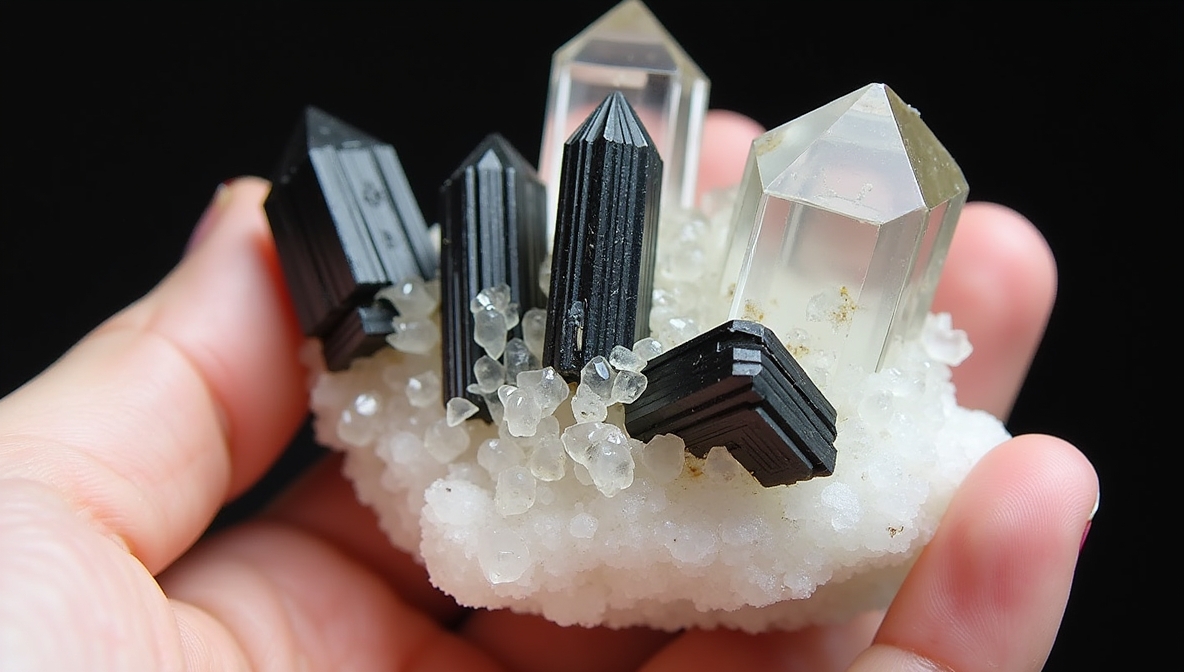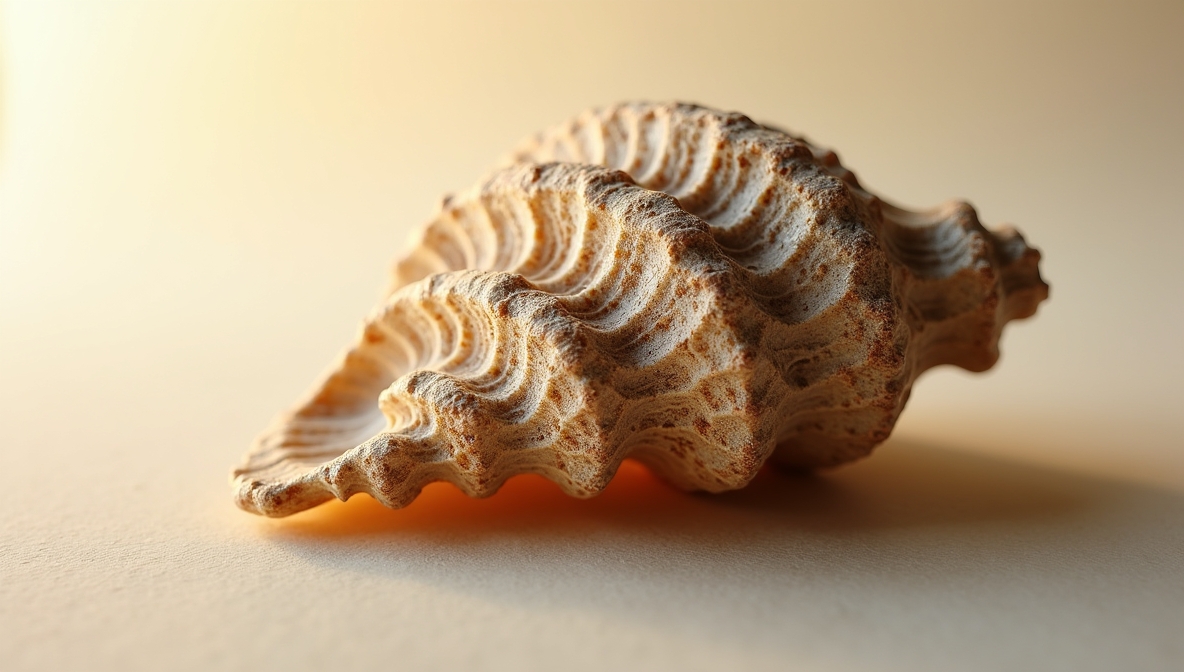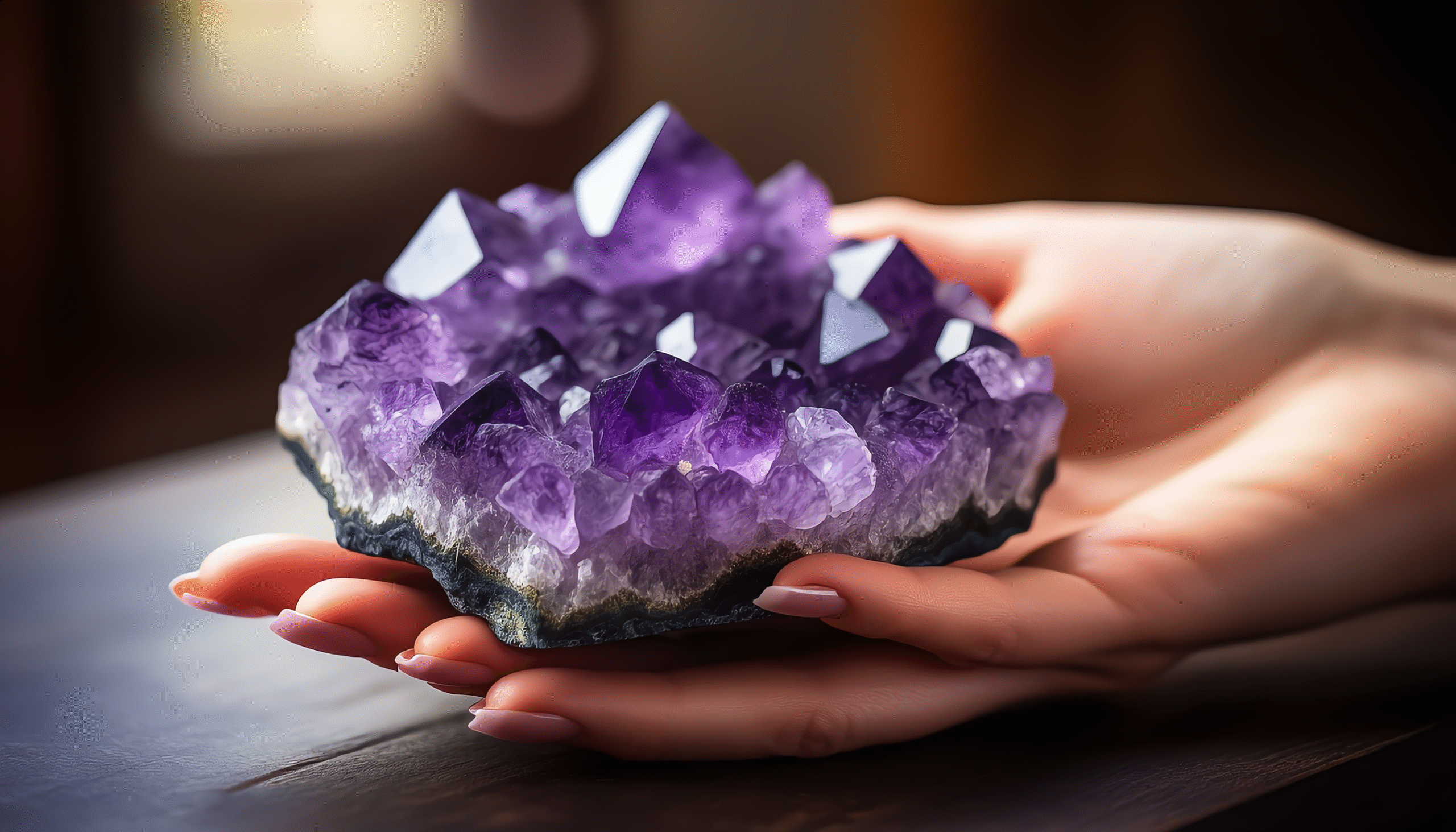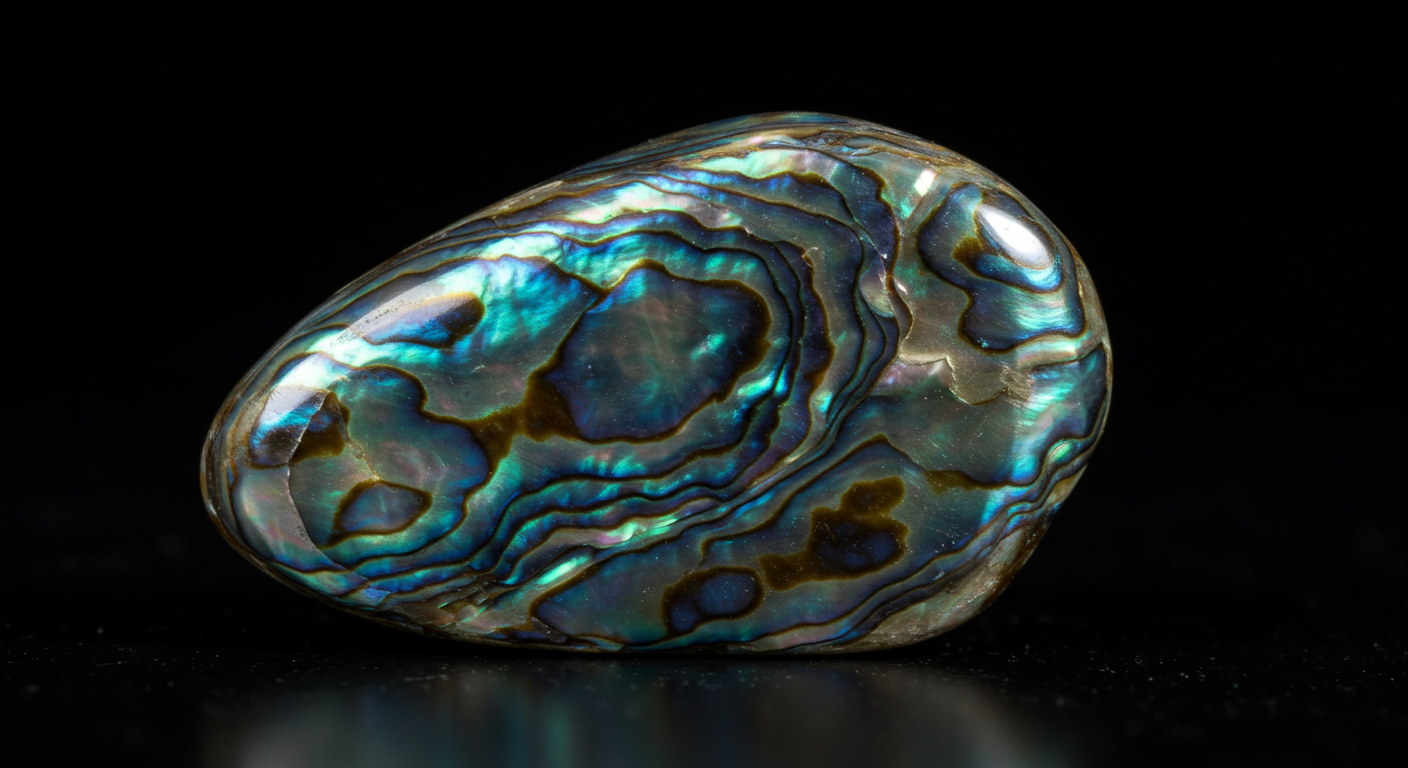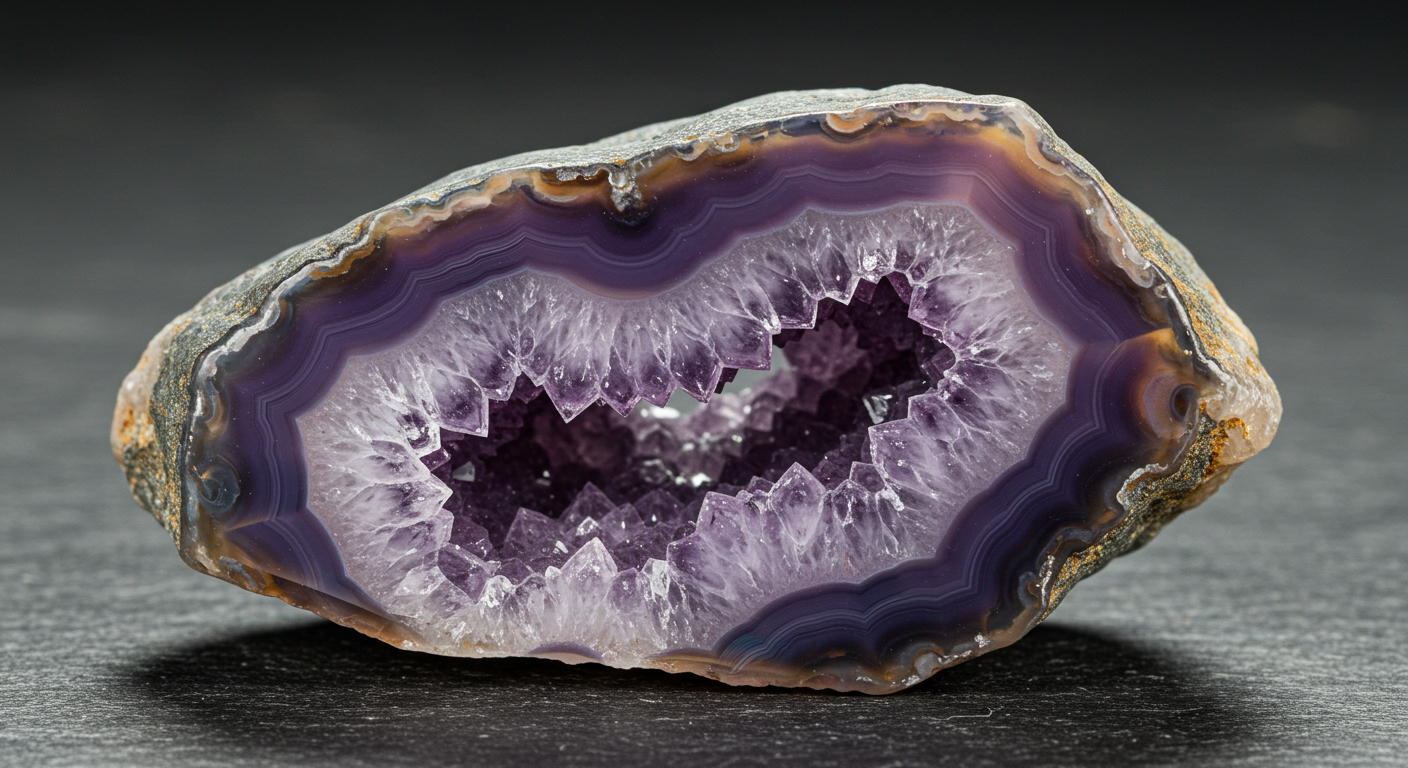See this incredible The Narrative of a Quartz, Tourmaline, and Feldspar Masterpiece. Explore its intricate patterns and natural beauty.
Imagine a tableau: the vibrant energy of Earth’s deep crust, brought to the surface, held in a human palm, and revealed by the precision of light. It is a moment of connection, captured in an image, embodied in a specimen. This isn’t just a photograph of a rock; it’s a visual story about time, chemistry, form, and the profound relationship between humanity and the raw beauty of our planet. We’re focusing on a particularly striking example: a well-formed cluster of clear quartz crystals adorned with prominent black tourmaline crystals, some attached externally, others suspended like ancient secrets within the quartz itself, all resting on a base of white feldspar matrix, presented in a hand under bright, even illumination.
This specific confluence of elements makes for a compelling subject, not just geologically, but artistically, particularly for mineral photography. Let’s break down the wonder held within this single frame.
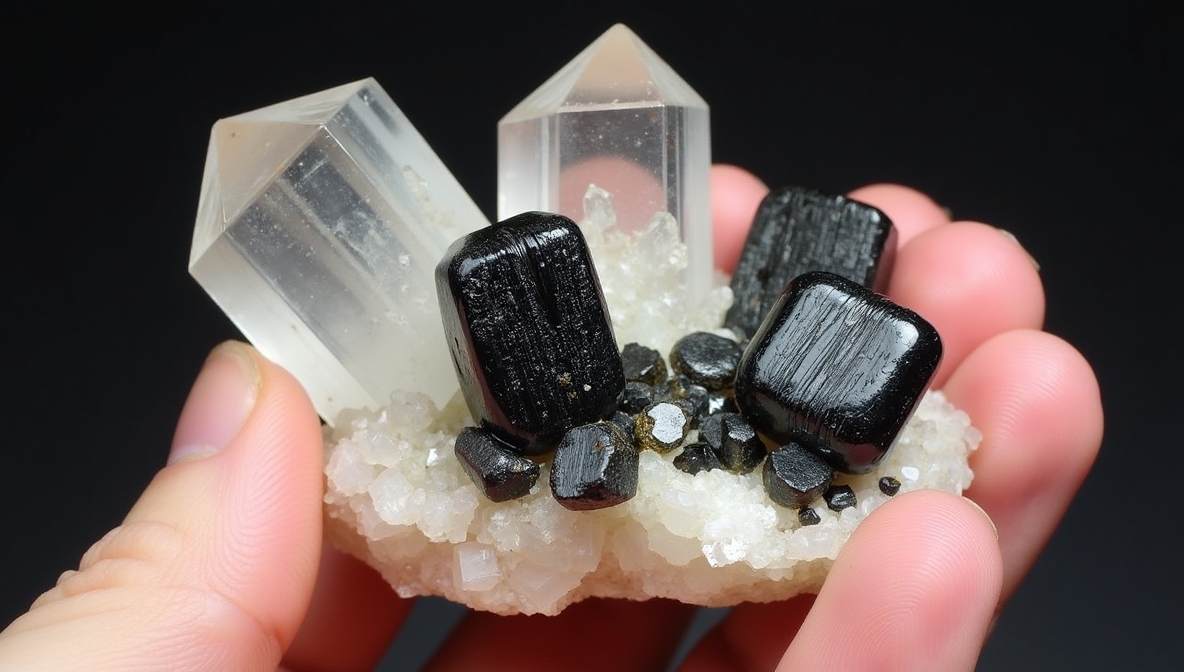
The Specimen: A Symphony of Contrasts and Forms
At its heart, this is a composition of three distinct mineral characters, each playing a vital role in the overall drama:
- The Clear Quartz Cluster: Quartz (SiO₂) is one of the most abundant minerals on Earth, yet a cluster of well-formed, clear crystals is always a marvel. In this specimen, the quartz crystals likely grew in a vug or cavity, extending outwards from the matrix base. Their form is typically hexagonal prisms terminating in pyramidal faces – a classic, elegant geometry. The clarity is paramount here. Transparent quartz acts like glass, allowing light to pass through, revealing internal features. It speaks of purity, ordered atomic structure, and growth in stable, unimpeded conditions. The cluster aspect adds complexity – multiple crystals intergrown, showing how they competed for space as they grew, creating fascinating angles, overlaps, and points.
- The Prominent Black Tourmaline Crystals: This is where the drama intensifies. Black tourmaline, specifically the iron-rich variety called Schorl, is often found growing alongside quartz and feldspar in specific geological environments like pegmatites or hydrothermal veins. Tourmaline crystals are typically prismatic, often exhibiting characteristic vertical striations along their faces. Their termination can vary, but is frequently a three-sided pyramid. Their color is a deep, intense, opaque black, absorbing light rather than transmitting it.
- Attached: The tourmaline crystals attached to the outside of the quartz or matrix create striking visual anchors. Their opaque black form provides a stark contrast in both color and light interaction against the clear, light-transmitting quartz and the lighter matrix. Their straight, often columnar shapes provide a geometric counterpoint to the possibly more varied forms of the quartz cluster.
- Included: The presence of tourmaline inside the clear quartz crystals adds another layer of fascination. These are “inclusions” – foreign mineral crystals that were trapped within the growing quartz crystal. This is a geological time capsule. It means the tourmaline was already present or growing alongside the quartz, and as the quartz crystal expanded, it simply engulfed the tourmaline, preserving it perfectly within its structure. These black needles or fragments suspended within the transparent quartz are incredibly aesthetic and tell a precise story: the tourmaline grew before or during the final stages of the quartz’s growth.
- The White Feldspar Matrix Base: The foundation of the piece. Feldspar is another incredibly common group of minerals, making up a large percentage of the Earth’s crust. It often forms the matrix or host rock for other minerals. In this specimen, the white color of the feldspar (likely a potassium feldspar like Orthoclase or Microcline, or a sodium-rich Plagioclase) serves as the perfect backdrop. White is the absence of color, a neutral stage that allows the black of the tourmaline and the clarity and form of the quartz to stand out without competition. The texture of the feldspar matrix might be granular, crystalline, or massive, providing yet another contrast to the smooth faces of the quartz and the striated surfaces of the tourmaline. The matrix tells us where and how these crystals began their growth journey, anchored to the pre-existing rock.
The synergy of these three components is what makes the specimen exceptional. The geometric clarity of quartz, the intense, opaque black geometry of tourmaline, and the neutral, solid white of the feldspar matrix create a natural sculpture with incredible visual appeal, built on fundamental geological relationships.
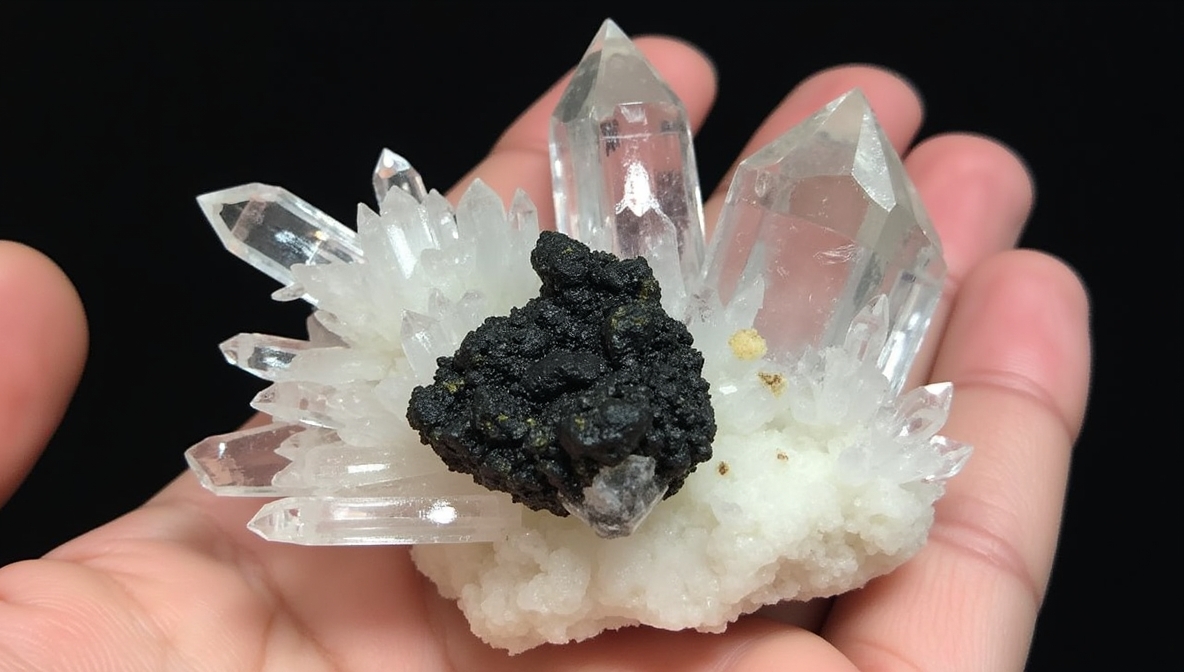
The Human Element: Held in the Hand
Placing the specimen in a human hand transforms it from a static object into a narrative piece. The hand is far more than just a prop; it’s an integral part of the composition and its meaning:
- Scale: The hand immediately provides a sense of scale. It allows the viewer to understand the actual size of the quartz crystals, the thickness of the tourmaline needles, and the overall bulk of the specimen. Without the hand, the viewer might have no reference for whether this is a miniature piece or a large display item.
- Connection: The hand represents the bridge between the ancient, inorganic world of minerals and the living, breathing, appreciating human. It signifies discovery, stewardship, and the human fascination with natural beauty. It adds a relatable, human touch to an otherwise purely geological subject.
- Tactile Imagination: Seeing the stone in a hand allows the viewer to imagine holding it, feeling its weight, its coolness, the texture of the different minerals. This creates a more immersive and personal connection with the image and the specimen.
- Implied Journey: The hand suggests the specimen’s journey from deep within the Earth, through human hands that likely extracted, cleaned, and prepared it, to the final moment of presentation.
- Compositional Balance: Artistically, the organic curves and flesh tones of the hand provide a soft counterpoint to the hard, geometric forms and stark colors of the minerals. It can frame the specimen, lead the eye, and add warmth to the overall image.
The hand isn’t just holding the stone; it’s presenting it, sharing it, inviting the viewer to connect with it on a more intimate level than if it were simply sitting on a shelf or a plain base.
The Illuminator: Bright, Even Light
The prompt specifies “bright even illumination.” This is crucial for mineral photography, especially for a specimen like this, and dictates how the viewer perceives its characteristics.
- Bright: Ensures sufficient light reaches the sensor or film to capture detail and color accurately without excessive noise (in digital photography). It allows for faster shutter speeds, which can be helpful when hand-holding (though the hand in the photo is likely stable). Bright light makes the specimen “pop” visually.
- Even: This is key to showcasing the specimen’s natural beauty without creating harsh, distracting shadows or blown-out highlights (areas that are too bright and lose all detail). Even light means the intensity of light is relatively consistent across the entire specimen.
- For Clear Quartz: Even light penetrates the clear crystals, revealing their internal clarity and allowing the black tourmaline inclusions to be clearly seen within the crystal lattice without shadows obscuring them. It minimizes strong internal reflections that can sometimes blow out the detailed inner structure.
- For Black Tourmaline: Even light softly wraps around the tourmaline crystals, highlighting their prismatic form and revealing the delicate vertical striations on their faces without creating harsh, blocky shadows. It defines their shape clearly against the lighter background.
- For White Feldspar: Even light illuminates the matrix uniformly, showing its texture and color consistently across the base, providing a clean, bright stage for the other minerals.
- For the Hand: Even light ensures the hand is also well-lit, showing its texture and tone naturally, without deep, distracting shadows that might compete with the specimen or make the hand look unnatural.
Bright, even illumination is often achieved using diffused light sources, such as light boxes, softboxes, or overcast natural light. This type of lighting is ideal for documentary-style mineral photography, aiming to show the specimen as clearly and accurately as possible, highlighting its form, color, texture, and internal features without dramatic, interpretive lighting effects (which can also be beautiful but tell a different visual story). In this case, the even light allows the natural contrasts inherent in the minerals themselves to be the primary visual focus.
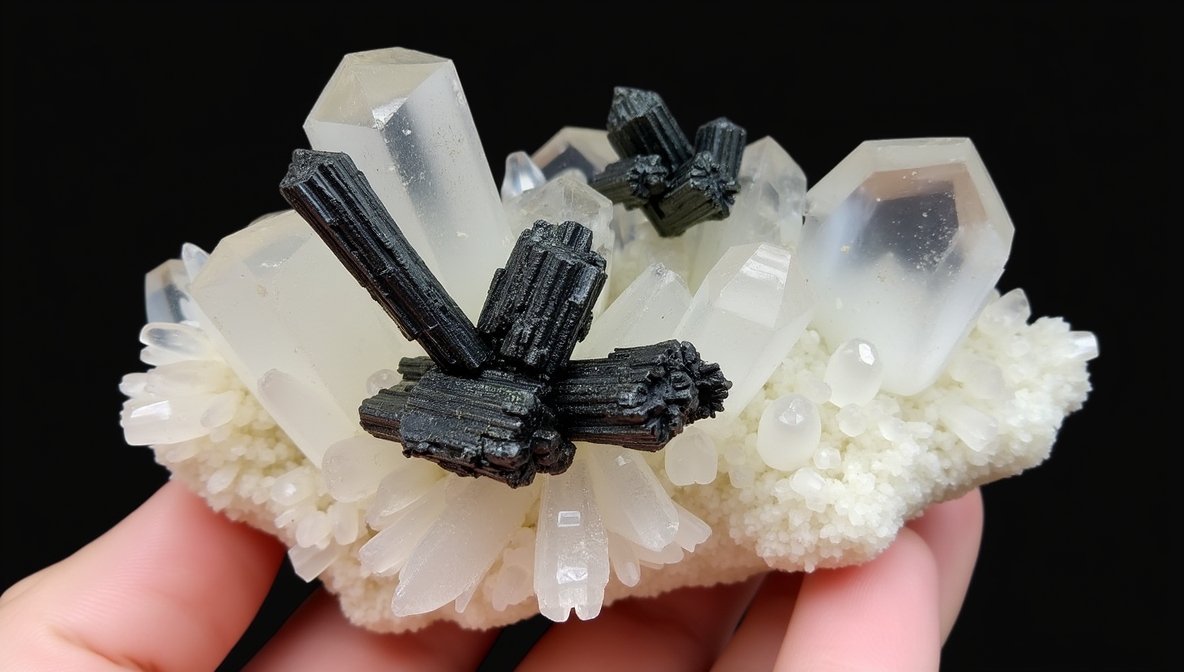
The Journey from Deep Earth to Captured Image
Consider the incredible journey this specific specimen has taken. It formed millions of years ago, deep beneath the surface, likely from hot, mineral-rich fluids circulating through fractures in the Earth’s crust (hydrothermal activity) or within a cooling body of magma (pegmatite). Silicon, oxygen, calcium, aluminum, potassium, sodium, iron, boron, and other elements, dissolved in these fluids, began to crystallize under specific conditions of temperature and pressure. The feldspar matrix formed first, providing surfaces for the quartz and tourmaline to nucleate and grow upon. The quartz and tourmaline crystals grew simultaneously or in sequence, competing for space and minerals, resulting in the observed attachments and inclusions.
After its formation, geological uplift and erosion brought the deposit closer to the surface. Discovered by a collector or miner, carefully extracted from the host rock, cleaned to remove dirt and debris, it is then presented – perhaps for sale, study, or simply admiration. The final step for our story is the act of photography – selecting the best angle, placing it carefully in the hand, and illuminating it perfectly to capture its essence in a digital moment.
Why This Specimen is a Photographer’s Delight
This particular combination of minerals offers a rich palette for a mineral photographer:
- Dynamic Contrast: The clear/opaque, light/dark, smooth/striated, geometric/potentially granular contrasts are incredibly photogenic.
- Variety of Textures and Forms: Quartz faces, tourmaline striations, feldspar texture offer tactile interest that translates visually.
- Storytelling: The inclusions tell a clear geological story captured in stone. The hand adds a human story.
- Light Play: The clear quartz interacts beautifully with light, revealing internal details that opaque minerals hide.
- Aesthetic Balance: The composition of three distinct elements provides visual balance and interest.
Under bright, even light, all these features are presented clearly and honestly, allowing the viewer to appreciate the specimen’s natural beauty and geological narrative without distraction.
Conclusion: A Moment of Shared Wonder
The photograph of a well-formed clear quartz cluster with prominent black tourmaline crystals, attached and included, resting on a white feldspar matrix base, held in a human hand under bright, even illumination, is more than just a picture. It is a carefully constructed window into the wonders of the natural world and the human connection to it.
It showcases the incredible ability of the Earth to create objects of geometric perfection and vibrant contrast through processes spanning millions of years. It highlights the distinct beauty and properties of individual minerals – the clarity of quartz, the intensity of tourmaline, the grounding presence of feldspar – and how they interact when found together.
The presence of the hand adds a crucial layer of meaning, providing scale, fostering a sense of connection, and reminding us that these ancient treasures are now studied, collected, and appreciated by people. And the bright, even light is the essential tool that reveals all these details, allowing the viewer to see the specimen clearly, honestly, and in all its natural glory.
This image, and the specimen it depicts, serve as powerful reminders of the Earth’s deep history, the beauty inherent in its structure, and the enduring human fascination with the crystalline treasures found beneath our feet. It is a captured moment of shared wonder – between the mineral, the hand, and the eye that beholds it.
